
Powdery mildew is a fungal disease that affects a wide range of plants. Powdery mildew diseases are caused by many different species of ascomycete fungi in the order Erysiphales. Powdery mildew is one of the easier plant diseases to identify, as the signs of the causal pathogen are quite distinctive. Infected plants display white powdery spots on the leaves and stems. This mycelial layer may quickly spread to cover all of the leaves. The lower leaves are the most affected, but the mildew can appear on any above-ground part of the plant. As the disease progresses, the spots get larger and denser as large numbers of asexual spores are formed, and the mildew may spread up and down the length of the plant.

Uncinula necator is a fungus that causes powdery mildew of grape. It is a common pathogen of Vitis species, including the wine grape, Vitis vinifera. The fungus is believed to have originated in North America. European varieties of Vitis vinifera are more or less susceptible to this fungus. Uncinula necator infects all green tissue on the grapevine, including leaves and young berries. It can cause crop loss and poor wine quality if untreated. The sexual stage of this pathogen requires free moisture to release ascospores from its cleistothecia in the spring. However, free moisture is not needed for secondary spread via conidia; high atmospheric humidity is sufficient. Its anamorph is called Oidium tuckeri.

Grape black rot is a fungal disease caused by an ascomycetous fungus, Guignardia bidwellii, that attacks grape vines during hot and humid weather. “Grape black rot originated in eastern North America, but now occurs in portions of Europe, South America, and Asia. It can cause complete crop loss in warm, humid climates, but is virtually unknown in regions with arid summers.” The name comes from the black fringe that borders growing brown patches on the leaves. The disease also attacks other parts of the plant, “all green parts of the vine: the shoots, leaf and fruit stems, tendrils, and fruit. The most damaging effect is to the fruit”.

Oidium is a genus of Deuteromycetes, where traditionally most anamorphs of the order Erysiphales are included. Most of them are plant pathogens causing different forms of powdery mildew, for example:

Erysiphales are an order of ascomycete fungi. The order contains one family, Erysiphaceae. Many of them cause plant diseases called powdery mildew.
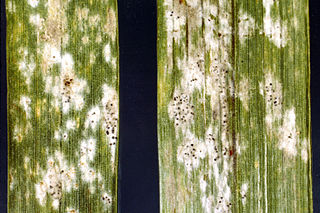
Blumeria graminis is a fungus that causes powdery mildew on grasses, including cereals. It is the only species in the genus Blumeria. It has also been called Erysiphe graminis and Oidium monilioides or Oidium tritici.
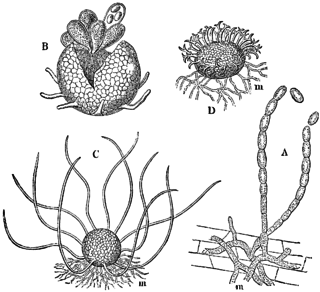
Erysiphe cruciferarum is a plant pathogen of the family Erysiphaceae, which causes the main powdery mildew of crucifers, including on Brassica crops, such as cauliflower, cabbage, broccoli, and Brussels sprouts. E. cruciferarum is distributed worldwide, and is of particular concentration in continental Europe and the Indian subcontinent. E. cruciferarum is an ascomycete fungus that has both sexual and asexual stages. It is also an obligate parasite that appears to have host specificity; for example, isolates from turnip will not infect Brussels sprout, and vice versa. While being a part of the family Erysiphaceae, it belongs to those members in which the conidia are formed singly and whose haustoria are multilobed.

Erysiphe betae is a fungal plant pathogen. It is a form of powdery mildew that can affect crops of sugar beet, that could cause up to a 30% yield loss. The fungus occurs worldwide in all regions where sugar beet is grown and it also infects other edible crops, e.g. beetroot.

Lasiodiplodia theobromae is a plant pathogen with a very wide host range. It causes rotting and dieback in most species it infects. It is a common post harvest fungus disease of citrus known as stem-end rot. It is a cause of bot canker of grapevine. It also infects Biancaea sappan, a species of flowering tree also known as Sappanwood.
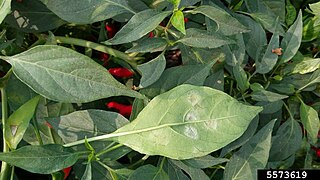
Leveillula taurica is an obligate fungal pathogen, from the phylum Ascomycota, which causes powdery mildew on onion. This disease prefers warm, dry environments. It is rare in the United States, and is currently restricted to western states. Globally, it is also a minor problem with limited occurrences in the Middle East, Europe, and South America. L. taurica causes powdery mildew of onions, but is also known to infect other allium, solanaceous, and cucurbit species. The disease has appeared in parts of the Middle East, the Mediterranean, and South and North America. Currently, it is not a cause for major concern in the U.S. and throughout the world, as its geographic extent is sparse. In addition, it is relatively easy to control through basic sanitation and reducing water stress.

Podosphaera leucotricha is a plant pathogen that can cause powdery mildew of apples and pears.

Podosphaera macularis is a plant pathogen infecting several hosts including chamomile, caneberrie, strawberries, hop, hemp and Cineraria. It causes powdery mildew of hops.
Erysiphe heraclei is a plant pathogen that causes powdery mildew on several species including dill, carrot and parsley.
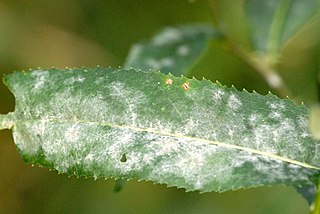
Erysiphe cichoracearum is a fungal plant pathogen that causes powdery mildew disease of cucurbits, including melon, cucumber, pumpkin, and squash. The primary symptoms are white, powder-like spots on the leaves and stems. Sphaerotheca fuliginea causes a similar looking powdery mildew of cucurbits.

Oidium mangiferae is a plant pathogen that infects mango trees causing powdery mildew. Powdery mildew of mango is an Ascomycete pathogen of the Erysiphales family that was initially described by Berthet in 1914, using samples collected from Brazil. O. mangiferae is found in all areas where mangoes have been raised long term, but is particularly widespread in India where both the host and the pathogen are native. Currently no teleomorph stage has been identified, but due to certain morphological characteristics it has been suggested that O. mangiferae belongs in the Erysiphe polygony group. Mango is the only known host for this pathogen, though O. mangiferae appears to be identical to fungi responsible for powdery mildew diseases on various other plant species, particularly oak, though some differences may be observed. In particular, the number of cells in conidiophores varies from 2 on mango to 3-5 on oak. O. mangiferae has been known to infect oak leaves in the laboratory, however due to the lack of a known teleomorph stage O. mangiferae is still considered to only be a pathogen of mango. Recent analysis of its ribosomal DNA suggests it is conspecific with Erysiphe alphitoides, the causative agent of powdery mildew in European oaks.
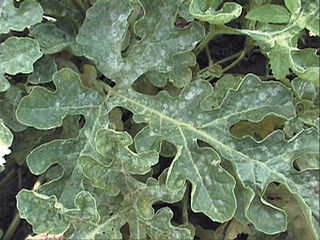
Podosphaera fuliginea is a plant pathogen that causes powdery mildew on cucurbits. Podosphaera fuliginea and Erysiphe cichoracearum are the two most commonly recorded fungi causing cucurbit powdery mildew. In the past, Erysiphe cichoracearum was considered to be the primary causal organism throughout most of the world. Today, Podosphaera fuliginea is more commonly reported.
This article summarizes different crops, what common fungal problems they have, and how fungicide should be used in order to mitigate damage and crop loss. This page also covers how specific fungal infections affect crops present in the United States.
Gummy stem blight is a cucurbit-rot disease caused by the fungal plant pathogen Didymella bryoniae. Gummy stem blight can affect a host at any stage of growth in its development and affects all parts of the host including leaves, stems and fruits. Symptoms generally consist of circular dark tan lesions that blight the leaf, water soaked leaves, stem cankers, and gummy brown ooze that exudes from cankers, giving it the name gummy stem blight. Gummy stem blight reduces yields of edible cucurbits by devastating the vines and leaves and rotting the fruits. There are various methods to control gummy stem blight, including use of treated seed, crop rotation, using preventative fungicides, eradication of diseased material, and deep plowing previous debris.
Isaria fumosorosea is an entomopathogenic fungus, formerly known as Paecilomyces fumosoroseus. It shows promise as a biological pesticide with an extensive host range.
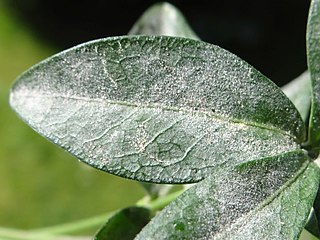
Golovinomyces orontii is a species of fungus that causes powdery mildew disease and it is in the family Erysiphaceae. It is an obligate biotroph that infects plants in several families including Acanthaceae, Asteraceae, Brassicaceae, Cucurbitaceae, and Lamiaceae.
















